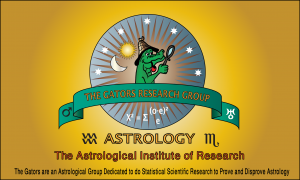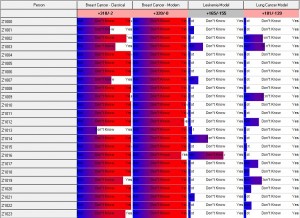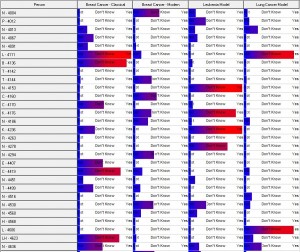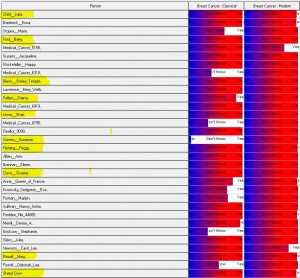INTRODUCTION
I am part of an astrological research team called the Astrological Investigators or affectionately known as the Gators. The Gators are led by world renowned astrologer Alphee Lavoie. This study was performed using the Fast Research module of the Air Software developed by Alphee Lavoie (www.alphee.com). The software was specifically designed for astrological research. The goal of the group is either confirm astrological hypotheses or disprove them with respect to health, wealth, weather prediction, marriage and other techniques used by astrologers. Alphee and I both come from a scientific backgrounds with engineering degrees and we have had statisticians as part of research group and guiding the construction of the software. The Astrological Investigators website is www.astroinvestigators.com.

THE SCOPE
The astrological chart is an assessment of a person’s potential in various facets of life such as career, relationships and as well as health. The purpose of this study is to determine the astrological characteristics or signature that appear in the birth charts of people who have been diagnosed breast cancer. Once a signature is established, it can be used to help predict the potential of breast cancer in a subject using their birth chart. The key point being this is the subject’s potential of breast cancer. There are many contributing factors to cancer such as life style, genetics and stress, to name a few, but the advantage to knowing if the potential is there, one can then adjust their lifestyle.
In order to be able to predict cancer based on an astrological chart, one would need to ensure the data comes from astrologers who had personally worked with the client in the past. Moreover, in order to conduct a meaningful study, a sizable amount of data is required. 316 timed charts with a Roden rating of AA were collected for this study.
In astrology, breasts are represented by the Moon in a person’s chart. The Moon rules several aspects such as childhood, our mother, and our feelings. The focus of this study will be on connections to the Moon and the astrological sign of Cancer, which the Moon rules, to breast cancer. There will be two subsequent studies on breast cancer. One on Venus which rules the feminine and thus also rules the breasts and final one which will also encompass the other facets such as Ascendant, Sun sign the 6th house of illness combined with Moon and Venus aspects.
The scope of this study will examine astrological factors affecting the Moon such as the aspect it makes to other planets, the Moon’s placement, phase, and as well as other factors.
ASTROLOGICAL CRITERIA
The astrological house system used in the study is Placidus.
The following criteria were examine using the Placidus House System, Ptolemaic aspects (0º, 60º, 90º, 120º and 180º) with ±4º orbs:
The Moon’s position in sign and house
- The Moon’s decanent
- The hemisphere placement of the Moon
- The Moon’s aspect to the mid-points of the other planets
- The aspect the Moon makes to its dispositor (Modern and Classical)
- The position in sign and house of the dispositor of the Moon (Modern and Classical)
- Which house has the sign of Cancer on the Cusp
- Planets in Cancer
- The planet that rises before the Moon
- The Moon’s aspect to other planets individual aspects and grouped into making any aspect to a planet
- The Moon’s aspect to a house ruler both individual aspects and grouped into making any aspect to a planet (Modern and Classical)
- The phase of the Moon
- The position of the Moon’s nodes in sign and house
- The planets that aspect the Moon
Note: the model was divided into a Modern Model with all the criteria plus Modern rulerships and a Classical model with all criteria plus Classical rulerships.
THE STATISTICS
In a statistical analysis, one of the key measuring factors is the Chi Square. I’m not going to get into an explanation of calculating Chi Square here as you can look that up on your own if you are interested but you’ll have to go back to university statistics for that. Chi Square is a statistical test that compares the measured value to the expected norm for that measurement.
Let’s say that you notice all the cars at the dealership are red, fast, and expensive. There is an occasional yellow or black car but a majority are red. So, you draw the conclusion that most cars are red, fast, and expensive. Is this a correct conclusion? Sure, if you are at the Ferrari dealership. Now you venture out to all the dealerships in your city and realise you were observing an anomaly or a very fixed sample base. Red, fast, and expensive would score a high Chi Square if you were observing only Ferrari dealerships. However, if you were to sample all the dealerships then the red, fast, and expensive would score low in Chi Square as most cars would be black, grey and white and would be mid-range priced.
Pickup trucks score high in Wyoming but low in Rome. Tuk tuks will score high in India but non-existent in North America, however worldwide the tuk tuk might score high because of the popularity and shear volume in the East. It is this concept that is important in statistical analysis. Therefore, in the astrology of breast cancer a certain characteristic should score high in people with breast cancer but low for people without breast cancer.
THE RESULTS
The breast cancer data consisted of 316 astrological charts. They were analysed using the Air Software (www.alphee.com) module Fast Research to determine the major contributors. A Chi Square = 1 is considered to be as good as chance or 50-50. The software was set to list only the contributors that gave a Chi Square of 2 or greater than chance and will indicate whether or not the contributor happened often or seldom. In order to determine the Chi Square, the breast cancer charts were compared against a control group. Seldom occurrences are as important as the ones that happen often.
The software calculated 158 events which registered higher than a Chi Square of 2. However, the results with a Chi Square of 6 or greater are tabulated in Table 1. They are broken down into Chi Square, Percent probability and whether the aspect occurred seldom in or often in breast cancer charts. A Chi Square of 6 is equivalent to a 98.5% probability or greater.
Note: makes an aspect means the planet makes any Ptolemaic aspect.
Table 1. Characteristics in Breast Cancer in Birth Charts
| EVENT | Chi SQ. | PROB | STAT |
| Moon Squares Pluto | 15.4 | 100.00% | OFTEN |
| The Dispositor Of Moon Aspects Pluto | 26.5 | 100.00% | OFTEN |
| Moon Aspects Neptune The Ruler Of The 10th House | 19.6 | 100.00% | OFTEN |
| Moon Aspects Mercury Ruler Of The 5th House | 14.8 | 100.00% | OFTEN |
| Moon Aspects Venus Ruler Of The 7th House | 12.7 | 100.00% | OFTEN |
| Moon Aspects Uranus Ruler Of The 11th House | 12.6 | 100.00% | OFTEN |
| Moon Makes Hard Aspect To Pluto | 12.0 | 99.90% | OFTEN |
| Moon Makes An Easy Aspect To Neptune | 11.4 | 99.90% | OFTEN |
| Moon In The Western Hemisphere | 12.0 | 99.90% | OFTEN |
| Cancer On The Cusp Of The 2nd House | 11.6 | 99.90% | OFTEN |
| Moon Aspects Mars Ruler Of The 11th House | 11.2 | 99.90% | OFTEN |
| Moon Opposite Mercury/Pluto Midpoint | 10.1 | 99.90% | OFTEN |
| Moon In The Last Decanate Of Taurus | 9.7 | 99.90% | OFTEN |
| Moon Square The Sun | 9.1 | 99.70% | OFTEN |
| Moon In The Northwest Quadrant | 9.0 | 99.70% | OFTEN |
| Dispositor Of The Moon In Libra | 8.1 | 99.50% | OFTEN |
| Moon Sextiles Venus/Neptune Midpoint | 7.9 | 99.50% | OFTEN |
| Moon Aspects Saturn Ruler Of The 8th House | 7.7 | 99.50% | OFTEN |
| Last Quarter Moon | 7.4 | 99.30% | OFTEN |
| Moon In The 5th House | 7.2 | 99.30% | OFTEN |
| Moon Aspects Neptune Ruler Of The 3rd House | 7 | 99.20% | OFTEN |
| Moon In 1st Decanate Of Taurus | 6.8 | 99.10% | OFTEN |
| Moon Aspects Ruler Of The 5th House | 6.7 | 99.10% | OFTEN |
| Moon Trines Mercury/Mars Midpoint | 6.4 | 98.90% | OFTEN |
| Moon In The Water Houses | 6.2 | 98.70% | OFTEN |
| Moon Sextiles Venus/Pluto Midpoint | 6.1 | 98.60% | OFTEN |
| Moon Aspects Pluto Ruler Of The 6th House | 6 | 98.60% | OFTEN |
| Moon Aspects The Sun Ruler Of The 5th House | 6 | 98.60% | OFTEN |
| Moon Aspects The Pluto Ruler Of The 5th House | 6 | 98.60% | OFTEN |
Table 2. Characteristics Not Found in Breast Cancer in Birth Charts
| EVENT | Chi SQ. | PROB | STAT |
| Cancer on Cusp of the 5th House | 22.9 | 100.00% | SELDOM |
| Moon Aspects Saturn Ruler Of The 11th House | 15.7 | 100.00% | SELDOM |
| Moon In The 11th House | 13.7 | 100.00% | SELDOM |
| Moon Aspects Pluto Ruler Of The 9th House | 13.4 | 100.00% | SELDOM |
| Moon In Air Houses | 12.0 | 99.90% | SELDOM |
| Moon In The Eastern Hemisphere | 12.0 | 99.90% | SELDOM |
| Moon In 2nd Decanate Of Leo | 10.2 | 99.90% | SELDOM |
| Moon Aspects Neptune Ruler Of 1st House | 9.8 | 99.80% | SELDOM |
| Moon In Aquarius | 8.9 | 99.70% | SELDOM |
| New Moon | 8.4 | 99.60% | SELDOM |
| Moon In The North Eastern Hemisphere | 8.0 | 99.50% | SELDOM |
| Moon Aspects Venus Ruler of the 3rd House | 6.6 | 99.00% | SELDOM |
NEURAL NETWORK ANALYSIS
The definition of a Neural Network from Wikipedia:
“In machine learning, artificial neural networks (ANNs) are a family of statistical learning algorithms inspired by biological neural networks (the central nervous systems of animals, in particular the brain) and are used to estimate or approximate functions that can depend on a large number of inputs and are generally unknown. Artificial neural networks are generally presented as systems of interconnected “neurons” which can compute values from inputs, and are capable of machine learning as well as pattern recognition thanks to their adaptive nature.”
Below is a video which has basic explanation of what a neural net is: https://www.youtube.com/watch?v=DG5-UyRBQD4
It is also called a Black Box model because what happens between the input and output is not known. The Fast Research programme has the capability to take all the contributors from the model based on what occurs often and what occurs seldom and develop a Neural Network which can predict the outcome based on all aspects of the chart. The inputs are weighted. The model is set up to assign Chi Squares of 4 or greater a weighting of +10 or -10 depending on if it happens often or seldom. Chi Squares of 2-3.99 are weighted at +/-5.
The input data for the model, 316 breast cancer charts, is randomly selected divided into a learning group (75%) and the testing group (25%). The concept of the Neural Net is to have it converge such that the learning group meets the yes condition 99% of the time and the test group meets the yes condition over 85%. This model for the modern rulerships did meet the convergent conditions. The accuracy of the model is verified such that the input data should score “Yes” and any non-breast cancer data should score “No”.
The figures below show how the model behaves when the breast cancer charts are compared to other types of cancer models. Subsequently it is checked with the charts of people who didn’t have breast cancer where Z= Breast cancer. There are two models for breast cancer, where one analyses modern rulership and one analyses classical rulership.
The figure below is a slice of the neural net results run for breast cancer. A positive chart for breast cancer will result in a completely coloured bar with no background showing. Small blue bar to the left with the white background shows a negative result. A partial bar approximately 75% to the right will be considered a positive result. In column one is the chart being examined. Z is our code for breast cancer. The second column is our model for breast cancer with classical rulership then the third is the model with modern rulership. Models for leukemia and lung cancer were also added to show how they did not pick up the breast cancer charts as they show a little bit of blue bar and white background.

Figure 1. Model Predicts Breast Cancer
Figure 2 below is a slice of the neural net results run for a random group of cancers. A positive chart for breast cancer will result in a completely coloured bar with no white background. In column one is the code name for chart being examined. Z is our code for breast cancer, L is lung cancer, N is non-defined, K is leukemia, T is throat, B is brain, etc. As before, the second column is our model for breast cancer with classical rulership then the third is the model with modern rulership. Models for leukemia and lung cancer were able to pick up their respective cancer charts as they show a completely coloured bar with no white background. One will notice that in a few instances the breast cancer model picked up lung cancer and often N – unknown will be picked up by the models.’

Figure 2. Other Forms of Cancer
While most of the subjects of the study are from astrologer’s files so they are titled Z for breast cancer and numbered, there were some more famous women who have had breast cancer in the study. The results are shown below. The Neural Net model was able to predict breast cancer in famous people who are known to have had breast cancer. The figure below shows the model predicting Julie Child, Betty Ford, Shirley Temple and Sheryl Crow all having breast cancer. They were all diagnosed as having breast cancer.

Figure 3. Breast Cancer Predicted for Famous People
CONCLUSIONS
In this study, we can see the model has actually performed well just using the Moon in the analysis where Modern rulership predicted breast cancer fully 95% of the time and classical rulership only 87% of the time based the ¾ red bar rule. We have developed the list of criteria that indicate breast cancer however, it is important to note that if one or two of the criteria are met, it does not mean the native will have breast cancer. The Neural Net examines the totals of the Often and Seldom criteria. Two high ranking Often will be negated by several Seldom criteria.
If the Neural Net analysis shows someone scoring high for breast cancer it is still dependant on life situations since the astrological chart is one of potentials.
We will be performing an analysis based on Venus and then adding in the Ascendant and Sun to build up to a complete model. We would still need more data in order to refine the model. We are continuing our studies and developing models that can predict various aspects of life such as career, wealth, and other areas of health.
The Astrological Investigators would like to collect more data on breast cancer. If you have had breast cancer and know if you know someone who has had it, we would need your birthday, place of birth and the exact time of birth. Please feel free to contact me. Please note: this is astrology and the exact time of birth needs to be known. If a birth time is off by 16 minutes, predictions can be off by 4 years.
